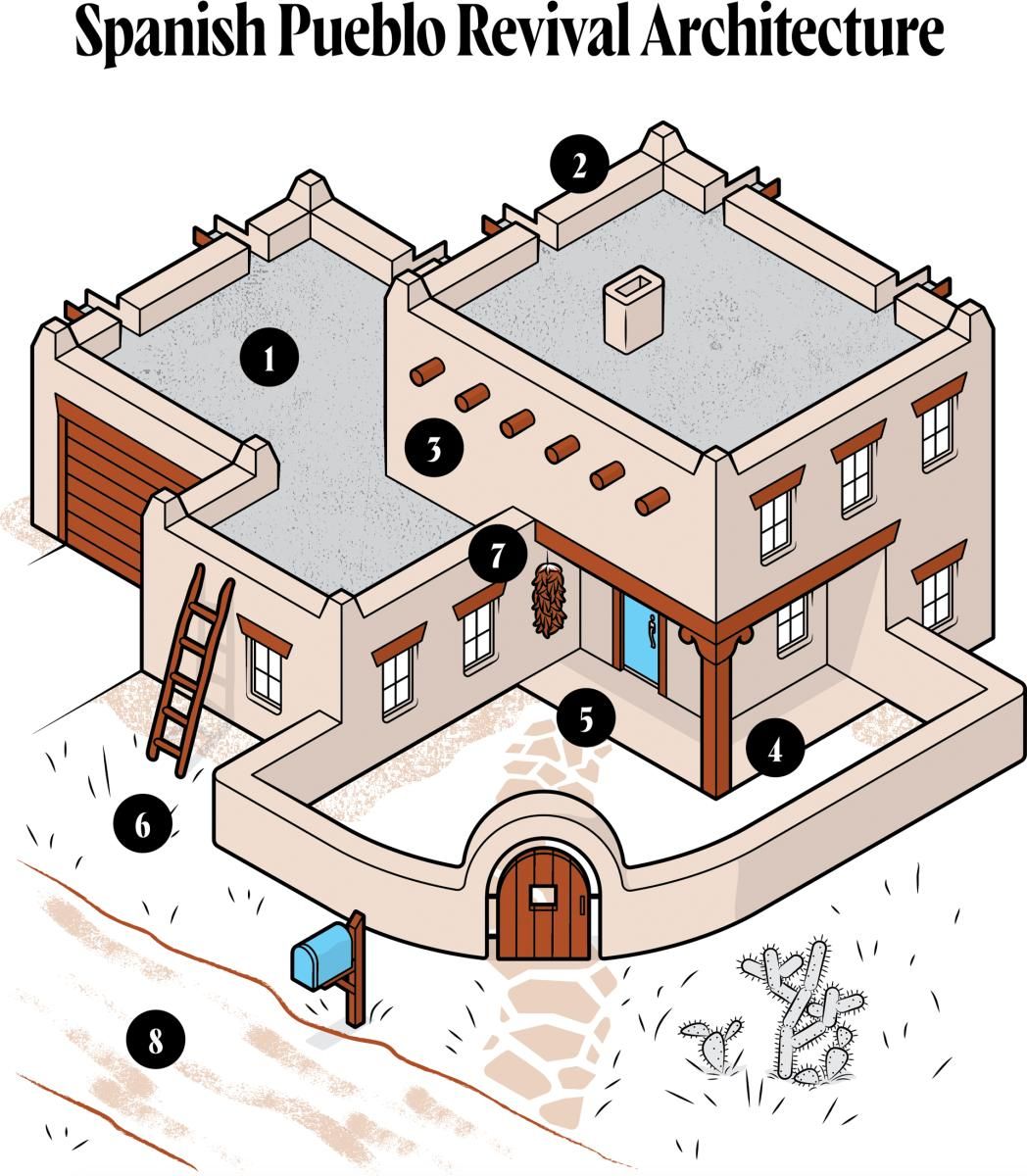From flat roofs to adobe-inspired walls, this Southwestern style blends tradition, culture, and sustainability into a uniquely American design language.

When we think of the architecture of the American Southwest, the Spanish Pueblo Revival style immediately comes to mind. Recognizable for its thick adobe-like walls, earthy tones, and handcrafted details, this design style is not just about aesthetics—it’s about history, culture, and adaptation to the desert environment.
The illustration above highlights the defining elements of Pueblo Revival architecture, a style that first became popular in the early 20th century but still inspires modern homes, resorts, and civic buildings today. Let’s break down each of these signature features:
1. Flat Roofs
Pueblo Revival homes are almost always capped with flat or gently sloping roofs, a direct nod to the indigenous Pueblo dwellings of the Southwest. These flat roofs are practical, helping conserve heat during cold desert nights while providing a surface that can be used for drying crops, relaxing, or even as an extra living area.
2. Parapets
The low walls extending above the roofline are called parapets. Traditionally, they served as protective barriers, especially when rooftops were used as workspaces or gathering areas. Aesthetically, parapets give the house its fortress-like appearance, emphasizing strength and permanence.
3. Vigas (Exposed Wooden Beams)
One of the most iconic elements is the viga, or projecting roof beam. These thick wooden poles extend beyond the walls, serving both structural and decorative purposes. In historic buildings, they supported the roof structure, while in modern designs, they’re often added for authenticity and rustic charm.
4. Portals (Covered Walkways)
Pueblo Revival homes often feature portals, shaded porches supported by wooden posts. These spaces provide shelter from the desert sun and act as transitional zones between indoors and outdoors. Function meets comfort, as portals make the home cooler while encouraging outdoor living.
5. Stucco Walls and Courtyards
The thick, stucco-coated walls mimic traditional adobe, giving Pueblo Revival homes their earthy, hand-molded look. Courtyards, like the one illustrated here, provide a private oasis—perfect for gatherings, gardening, or simply escaping the heat.
6. Wooden Ladders
In traditional Pueblo culture, wooden ladders connected different levels of multi-story dwellings. Even in revival-style homes, they’re often included as decorative features that evoke the heritage of indigenous design.
7. Decorative Touches
Details such as hanging red chile ristras (stringed chili peppers), rustic wooden window frames, and carved entryways add a regional identity to Pueblo Revival homes. These elements celebrate local craftsmanship while creating a welcoming, homey atmosphere.
8. Desert Landscaping
Finally, the environment completes the look. Pueblo Revival homes often sit within desert landscapes, surrounded by native plants like cactus, yucca, and mesquite. Stone pathways and earth-toned exteriors ensure the architecture feels like an extension of the land itself.
🌵 Why Pueblo Revival Still Matters
This architectural style is more than a nostalgic tribute—it’s deeply practical. Designed to handle hot days, cool nights, and arid conditions, Pueblo Revival homes naturally regulate temperature, making them energy efficient. Their reliance on local materials and integration with the landscape reflects a sustainable philosophy that feels incredibly modern.
✨ Key Takeaway
The Spanish Pueblo Revival style is a masterclass in blending indigenous ingenuity, Spanish colonial influences, and modern needs. Its charm lies in its authenticity—thick walls, earthy palettes, and handcrafted details that tell a story of culture, adaptation, and timeless beauty.